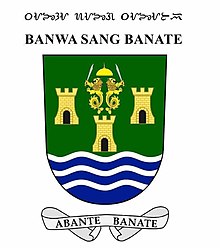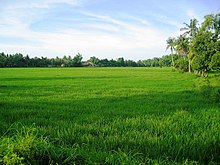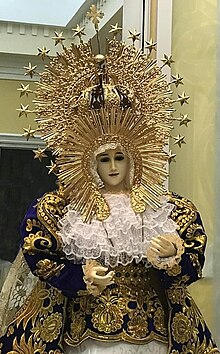Banate, Iloilo
[3] The town is primarily a fishing and agricultural municipality, with large areas planted with rice, sugarcane, vegetables, beans, coconut and bananas.Banate is well known for Kasag (crabs), krill or shimp paste called ginamos, and the fresh fish, which local entrepreneurs take to and sell in the capital of the province, in many of the non-coastal towns, and even in Manila.In these places they cultivated the land, planting kauayan, mabulo, hidiok, bagtikan, sibukao, buri, niog, kulo, kalamansi, paray, batad, kahangkugui and other seed, which they brought from Borneo.[10] Alakaygan and Bubug (Bobog), which gave its name to the ancient society and where the future Spanish population would develop, were among the first settlements established by the Malays in Panay.[11] As a side note, Alakaygan is the only place in Banate where, until recent years, Tapukal (krill or hipon smoked in the bark of a native tree) was produced.[20] By the end of the 1700s, the inhabitants of Banate have already finished building three stone bastions located at its shores, which defended the town from marauding moros of Mindanao.By beginning of the 1800s, the Spaniards noted that Banate profited from the benefit of its good bastions that the native residents built to defend themselves from the moro pirates.During the later part of the 19th century the present Roman Catholic stone Church was constructed in the adjacent barangay which subsequently became the Poblacion or the capital of the town.[20] In his decree, the Governor General noted that Banate was already separated from Barotac Nuevo in its temporal administration, and after consulting with the various Spanish colonial authorities, including the Bishop of Cebu (who had ecclesiastical jurisdiction of the entire Visayas) and the Governor of the Region, he deemed it opportune to decree the separation of the town's spiritual care from its mother Parish of Barotac Nuevo.[32] That year (1855), official records in the National Archives in Manila attest to the election of Capitan Don Tomas Juanico as Gobernadorcillo of Banate, and the following were the other town officials: D. Alfonso Arroyo- Primer Teniente, Pablo Becenra- Segundo Teniente y Juez mayor de Ganados, Sabino Apacible- Juez mayor de Sementeras, Claudio Juanico- Juez de Policia, Fabiano Baquisal- Primer Alguacil, Tobias Bacabac- Segundo Alguacil, Luis Banbeno-Tercer Alguacil.Within very short years after the resettlement of the town, Banate recovered to be a notable community with plenty of rice, sugar, tobacco, and pineapple fiber fabrics, which the women produced.[36][note 2] On 28 October 1898, during the Revolution for Philippine Independence, Banate (which remained loyal to Spain) was reduced to ashes by the rebels under the ill-mannered Juan Maraingan -[37] a leader of one of the bandit groups or "aggraviados" (boyongs, pulahanes, and tulisanes), who took advantage of the unsettled times to come down and attack the Spanish forces and unprotected towns and villages.He took his religious vows in the Colegio de Valladolid in 1844, and ministered the parishes of San Pedro (1850), Banate (1854) and Igbaras (1858) in Visayas, dying in this last town assignment, on June 13, 1861.[47] Fray Calvo was among the 13 Augustinian priests and 7 friars in minors orders, who were given the Royal permission by Queen Isabela II, on 20 January 1845, to embark from the port of Santander, for Philippine mission.After having taken religious profession in the Colegio de los Agustinos of the aforementioned city on 13 May 1851 and, having received the Royal mandate of Queen Isabela II earlier, on 25 September 1854 (No.[49] Here he was ordained a priest and, soon after, obedience destined him to go to the province of Iloilo, where he administered the towns of Banate in 1859, and Barotac Nuevo from 1865 to July 2, 1878, date of his death.It was from Pavia where, full of the spirit of God and eager to preach the Gospel to the pagans, he went to the missions of Hun-Nan (China) where he continued to work in such a glorious zeal.[59] An extant document of the Report made by Fray Lope regarding the description of the Parish and its people, as well as describing the Church properties in Banate, exists in the custody of the Monastery of the Augustinian Province of the Most Holy Name of Jesus of the Philippines in Valladolid, Spain.Fray Arquero is also known for the manuscript he redacted on 1 January 1897, regarding the statistical data and historical information of the Parish of St. John the Baptist in Banate, Iloilo (Philippines)at the later part of the Spanish rule.2657 of the Insular Government of the Philippine Islands, dated 31 December 1916, shows Banate as one of the 24 Municipalities in Iloilo,[73] and of the five towns belonging to the Fifth District the Province.Based on the 1990 record, the majority of the Banatenhon's are Roman Catholics (16,338 or 70%); the next religious denomination with the second highest number of adherence are the Aglipayans or the members of the Philippine Independent Church (5,057 or 22%); there are 750 Protestants who comprise 3% of the population; Iglesia ni Kristo has 203 churchgoers or 1% of the population; and members of other religious sects like United Church of Christ in the Philippines, Jehovah's Witnesses, Seventh Day Adventist, Muslims, etc.[93] Cemetery about five hundred meters distant from the Poblacion settlement; and located on the road that leads to the mountain near the hill called "Cambang-bato", which was enclosed by a short wall[94] made of (bamboo) cane.Parcon, the Congregation of the Most Holy Redeemer (Redemptorist Fathers) had a mission in Banate, during which a number of Aglipayans converted to Catholicism, as noted in the parish register of Baptisms.Masses are held, in both Roman Catholic and Aglipayan Churches after which, devotees' carry in procession a decorated carroza containing the statue of the Patron saint through the main streets of the town.The townspeople cook typical delicious dishes for the guests to eat and, later in the afternoon, children as well as teenagers go to the plaza to enjoy the fun at the "peryahan".In the evening, a "search" for Miss Banate is held in the municipal covered gymnasium, where the crowd would pack in the gym, in order to cheer for their respective candidates.The idea of the Kasag Festival as a vessel for the promotion and marketing of the town product sprung from the OTOP Coordinator during the OTOP presentation at Passi City, Previous Street Dancing Competitions were held every 24th day of June, as one of the highlights of the final day of the Annual Town Fiesta honoring and thanking God through the intercession of St. John the Baptist for the fruitful year spent.However, the activities meant at integrating Kasag Festival with the Feast of St. John the Baptist proved to be such a tedious endeavor for Banatenhons, requiring much of their time and effort.Most often, this results in distractions, if not deviations, from the original essence and spirit of the religious fiesta which is about the devotion to St. John the Baptist and thanksgiving to the Almighty God.The current "cultural ambassadors of Banate" are known for their merry and lively dance which depicts the townpeople's livelihood as fishermen, and the town's famed product: "Kasag" or crab(s).














Banate (disambiguation)MunicipalityPhilippinesCountryRegionWestern VisayasProvinceIloilo
4th districtFoundedBarangaysSangguniang BayanVice MayorMunicipal CouncilHouseholdsEconomyPoverty incidenceRevenueAssetsExpenditureLiabilitiesTime zoneZIP codearea codeNative languagesHiligaynonTagalogginamosManilaBoxer CodexVisayansConfederation of Madja-asthalassocraticSumatraIndonesiaSoutheast AsiaSulawesiMaragtasCarl LinnaeusGuimbalDumangasBarotac Nuevobastionsheraldic artGobernadorcilloPoblacionRoman CatholicGovernor GeneralAugustinian Province of the Most Holy Name of Jesus of the PhilippinesValladolidmanuscriptfull-timeparish priestPrincipalíaprincipalesO.S.A.Province of OviedoAsturiasQueen Isabela IIBurgosFirst Spanish RepublicCornagoLa RiojaToledoLudovico Arroyo BañasUSS ConcordInsular Government of the Philippine IslandsIloilo CitypurokssitiosprecipitationPhilippine Statistics AuthorityUrban densityBlessed Virgin MarytranseptMater DolorosaSt. John the BaptistKasadyahanDinagyang FestivalAliwan FiestaNegrosNeocatechumenal WayKiko Argüello (DILG)noblezaHistory of the Philippines (1521–1898)Wayback Machineprovincia de OviedoLocal Water Utilities AdministrationSan EnriqueBarotac ViejoAnilaoMunicipalitiesAlimodianBadianganBalasanBingawanCabatuanCalinogCarlesConcepcionDingleDueñasEstanciaIgbarasJaniuayLambunaoLeganesLemeryMaasinMiagaoNew LucenaPototanSan DionisioSan JoaquinSan MiguelSan RafaelSanta BarbaraTigbauanTubunganZarraga